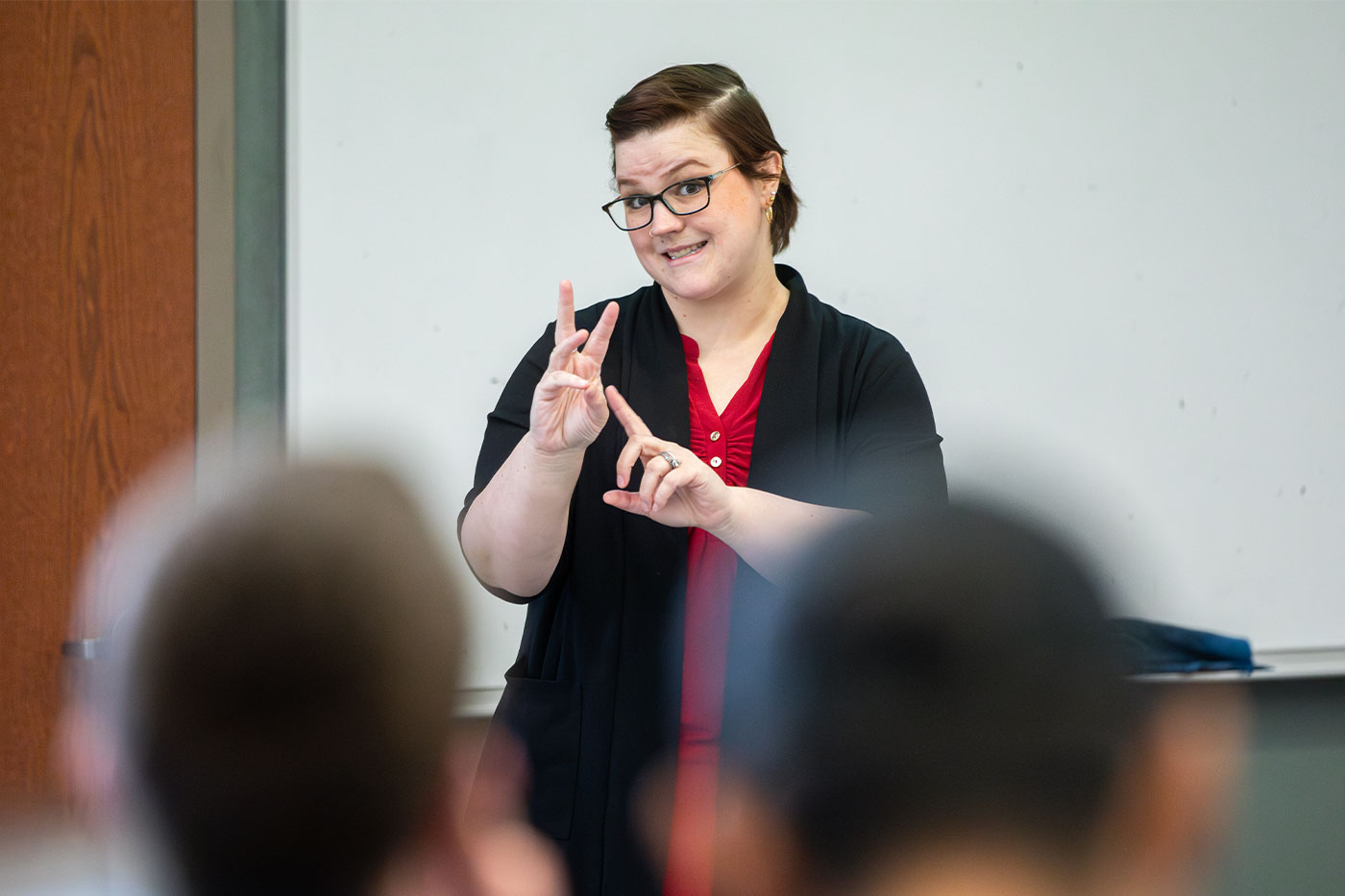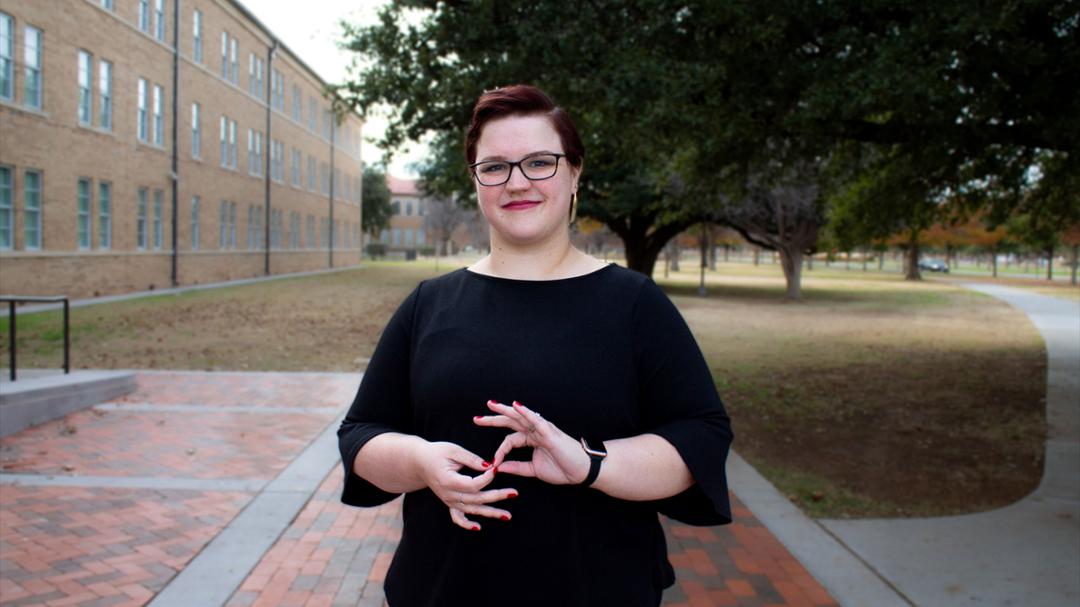Elizabeth Dutra practices her passion for American Sign Language multiple times a day as she connects professors’ words with hard-of-hearing students.
Elizabeth Dutra looks forward to five classes a weekday each semester on the Texas Tech University campus – yet she is not an enrolled student.
She learns subjects of all varieties, but never has to take a test. She sits next to the professors, but she is not their assistant.
Instead, her focus is on the student in front of her as she conveys lessons through complex gestures and expressions that make up American Sign Language (ASL).
“Our coordinator looks at our schedule and the students’ schedules and then assigns us to these classes,” she said. “So, I work with several students throughout the day in all different majors. Sometimes it’s very interesting to go from an engineering class to animal sciences. It’s different, but that makes it fun and interesting.”

Dutra is a sign language interpreter with Student Disability Services. After two years in this role, she jokes that through these additional lessons, she understands math better than when she was in school. But despite not having the normal responsibilities of a student, Dutra still finds herself doing homework before each class.
“We do a lot of prep work,” she said. “When we have a moment available, we look up signs to see if we can find something that’s already established in that area because we want to try and match what’s already being used.”
Dutra is accustomed to the eyes of many more students than just the hard-of-hearing landing on her during the lesson. While the interest in her movements typically fades as the semester speeds by, she said the appreciation from the professors remain.
Making classes accessible feels rewarding to Dutra, but it is far from easy as most languages do not require simultaneous interpretation.
“In Spanish, they listen to the speaker in English and then they chunk it,” she explained. “They wait until they’re done with whatever they’re talking about and then repeat it. But we are roughly seven to 10 seconds behind the speaker, so it’s a very large mental load.”
That’s the reason there are ideally two sign language interpreters per class, taking turns after about 20 minutes and supporting each other from an “off seat” by occasionally providing clarity if needed.
Then, if the student has a question, they will raise their hand and sign to Dutra while she interprets aloud. She is happy to do so, as she becomes an advocate for these students from their first year to graduation.
“We get to know the students throughout their time here,” she said. “It’s really cool to see the progression of their classes and how they grow, and it’s bittersweet to see them go on to their next stage of life because you care about them.”
Dutra keeps her nails neutral and makes sure to wear solid-colored shirts with longer sleeves to deter any distractions. She even covers her light office walls with a dark blue background to ensure enough contrast for an easy viewing experience during online classes.
These are just a few tips she has learned during her 10 years as a sign language interpreter. But her interest in aiding those hard of hearing started from the moment she first encountered a deaf person at 7 years old.
Original Outreach
Dutra was at church when she observed someone communicating through ASL and her childhood curiosity piqued.
She decided she would ask her teacher to find her ASL classes – an easy enough task since that teacher was her mom.
Ironically, the instructor her mom found to teach these homeschool lessons was Lori Mallory, now an ASL senior lecturer with the Department of Classical & Modern Languages & Literatures.
At the time, Mallory had just graduated from Texas Tech with a bachelor’s degree in early childhood education. She also was the new mother of a daughter who made the fourth deaf generation in her family – herself being the third.
She remembers feeling touched that Dutra was motivated to learn ASL.
“We’re living in a hearing world, so it’s really nice to have that bridge between the hearing and the deaf world,” Mallory said. “If the hearing want to learn the language, then that’s great because we can work together to communicate with each other.”
Dutra got to practice what Mallory taught her with one of her seven siblings who also took the courses. It was not until Dutra was 15 that she had a professional opportunity to interact with a deaf coworker at her grocery store job.
“I was interpreting between coworkers, not even knowing that what I was doing was interpreting,” she mused.
Around that same time in her adolescence, Dutra realized she could make a career of interpreting.
“I thought it was really amazing I could do something I love with a group of people I love and be passionate about what I do,” she recalled. “So, I went to college to have official interpreter training.”
But it was not just any college. Dutra chose to attend the Interpreter Training Program at Southwest College for the Deaf in Big Spring, Texas, which is a deaf campus. Dutra’s classes were taught by deaf instructors and she lived with a deaf roommate.
For the next two years, Dutra ate, breathed and slept ASL. She reminisced on the embarrassment of her early miscommunications, but she considers those blunders well worth it.
“There are so many nuances that I would not have picked up on and internalized without that experience, because when you want to learn Spanish, you can go to Spain and do a study abroad trip and become pretty fluent from that,” she said. “It was the same for me – that was my immersion and I think it was perfect.”
Dutra had to learn specific facial expressions and movements that are involved in ASL as well as slang. Soon she began to communicate with students from several different generations and nationalities.
By the time she graduated in 2014, she recognized she was far from the roughly seven years it takes to become fluent in a language. She also was pregnant with her daughter, so she decided to take a year-long break.
In 2016, after taking a refresher course, Dutra was hired as a sign language interpreter with an agency in the Big Spring area and placed with experienced interpreters who continued her training.
“There’s a huge gap between graduating from an interpreter training program and actually being ready and qualified to work,” she admitted. “I was fortunate to have somebody get me where I needed to be to get certified and continue my professional career.”
Signing Into a Career
Since there were not many big events for Dutra to interpret for, she began to accompany deaf individuals to engagements like weddings, funerals and doctor appointments.
“I like to tell doctors that I’m there to interpret for them because they don’t know how to sign,” she explained. “In a perfect world, everybody could sign, but unfortunately it’s not a perfect world.”
By 2020, Dutra began to spread her expertise in another familiar place: Lubbock. Her husband had just started a new job, and she found there were more opportunities to get involved as an interpreter in her former community.
She started serving on the board for Caprock Society of Interpreters for the Deaf, attended monthly events like “Deaf Coffee Chat,” and discovered her passion for interpreting theatre and music through the Lubbock Community Theatre.
“I’m a little theater kid at heart, so doing something besides math classes is a lot of fun,” she said. “Getting to interpret “Be Our Guest” from “Beauty and the Beast” is so different and challenging. It gets my brain thinking creatively and outside the box.”
Dutra began to interpret under contract, switched to part time and then was hired at the Lubbock Independent School District until her full-time position opened at Texas Tech. Working on campus is special to her, as both of her parents were Red Raiders in the 1980s when they met through the Air Force ROTC program.
While she might not be attending each class to further her education, she plans to further her Board for Evaluation of Interpreters certification from Basic to Advanced.
“We’re going to work on some specific skills to get me to that point,” she said. “I’m really excited about that.”
Dutra hopes more Texas Tech students will consider learning ASL as their major, minor or foreign language requirement. Not only can an understanding of ASL open doors to job opportunities in the future, but she said it meets a growing need.
“Deaf people will always be here, so being able to communicate with a unique group of people is a neat thing to be able to do,” Dutra said. “It can really make a huge difference for the people in our community if you’re able to communicate on a basic level, even if it’s just, ‘Hello, good morning.’
Mallory agrees, giving the example of when she dines at a restaurant and the server knows a bit of ASL.
“Then I can order and they can help me in my language,” she explained. “It’s always nice meeting somebody who knows sign language because we’re able to have that human connection.”
Students who not only want to become that bridge from the hearing to deaf world, but take their understanding a step further like Dutra did, can enroll in Texas Tech’s ASL/English Interpretation major. Although she warns – from experience – doing so could be life changing.
“Who would have thought that a 7-year-old’s little interest would become this career later on,” she said with a laugh. “I’m just grateful for the people who have mentored me and taught me the right and wrong things to do, as well as the deaf community for supporting me and growing me. When I look back, I feel so blessed to have had ASL be such a big part of my life because I definitely feel like it’s shaped who I am.”

